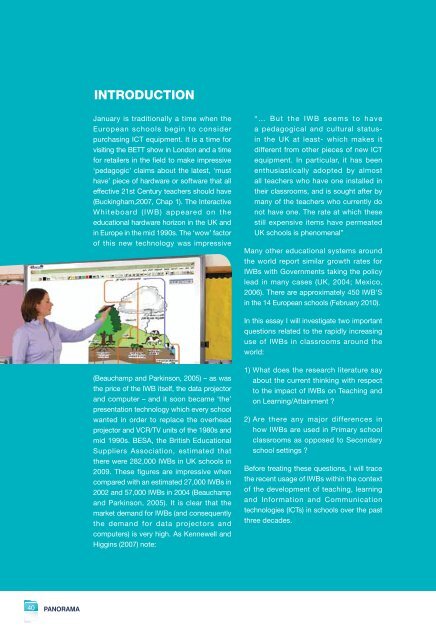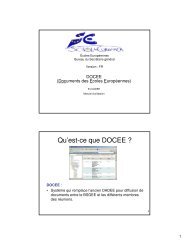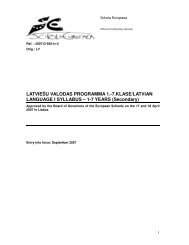Schola Europaea European School Brussels II
Schola Europaea European School Brussels II
Schola Europaea European School Brussels II
Create successful ePaper yourself
Turn your PDF publications into a flip-book with our unique Google optimized e-Paper software.
40<br />
PANORAMA<br />
INTRODUCTION<br />
January is traditionally a time when the<br />
<strong>European</strong> schools begin to consider<br />
purchasing ICT equipment. It is a time for<br />
visiting the BETT show in London and a time<br />
for retailers in the field to make impressive<br />
‘pedagogic’ claims about the latest, ‘must<br />
have’ piece of hardware or software that all<br />
effective 21st Century teachers should have<br />
(Buckingham,2007, Chap 1). The Interactive<br />
Whiteboard (IWB) appeared on the<br />
educational hardware horizon in the UK and<br />
in Europe in the mid 1990s. The ‘wow’ factor<br />
of this new technology was impressive<br />
(Beauchamp and Parkinson, 2005) – as was<br />
the price of the IWB itself, the data projector<br />
and computer – and it soon became ‘the’<br />
presentation technology which every school<br />
wanted in order to replace the overhead<br />
projector and VCR/TV units of the 1980s and<br />
mid 1990s. BESA, the British Educational<br />
Suppliers Association, estimated that<br />
there were 282,000 IWBs in UK schools in<br />
2009. These figures are impressive when<br />
compared with an estimated 27,000 IWBs in<br />
2002 and 57,000 IWBs in 2004 (Beauchamp<br />
and Parkinson, 2005). It is clear that the<br />
market demand for IWBs (and consequently<br />
the demand for data projectors and<br />
computers) is very high. As Kennewell and<br />
Higgins (2007) note:<br />
“… But the IWB seems to have<br />
a pedagogical and cultural status-<br />
in the UK at least- which makes it<br />
different from other pieces of new ICT<br />
equipment. In particular, it has been<br />
enthusiastically adopted by almost<br />
all teachers who have one installed in<br />
their classrooms, and is sought after by<br />
many of the teachers who currently do<br />
not have one. The rate at which these<br />
still expensive items have permeated<br />
UK schools is phenomenal”<br />
Many other educational systems around<br />
the world report similar growth rates for<br />
IWBs with Governments taking the policy<br />
lead in many cases (UK, 2004; Mexico,<br />
2006). There are approximately 450 IWB'S<br />
in the 14 <strong>European</strong> schools (February 2010).<br />
In this essay I will investigate two important<br />
questions related to the rapidly increasing<br />
use of IWBs in classrooms around the<br />
world:<br />
1) What does the research literature say<br />
about the current thinking with respect<br />
to the impact of IWBs on Teaching and<br />
on Learning/Attainment ?<br />
2) Are there any major differences in<br />
how IWBs are used in Primary school<br />
classrooms as opposed to Secondary<br />
school settings ?<br />
Before treating these questions, I will trace<br />
the recent usage of IWBs within the context<br />
of the development of teaching, learning<br />
and Information and Communication<br />
technologies (ICTs) in schools over the past<br />
three decades.
















